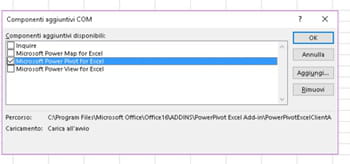- Microsoft PowerPivot for Excel 2010: Give Your Data Meaning introduces PowerPivot in Excel 2010 to power users and data analysts who want to give their data meaning by creating their own Business Intelligence models. And with Microsoft Excel 2010: Data Analysis and Business Modeling, you'll learn the best ways to use Office Excel 2010 for data analysis and business modeling.
- PowerPivot for Excel can be installed on a computer that has 32-bit or 64-bit Excel 2010. If you have installed the 32-bit version of Excel, you must install the 32-bit version of PowerPivot for Excel. Likewise, if you have installed the 64-bit version of Excel, you must install the 64-bit version of PowerPivot for Excel.

 Over the years, knowing whether you have access to the Power Pivot feature in Excel has been challenging at times to say the least. First introduced as an add-in for Excel 2010, availability of the tool has varied, depending upon which version of Excel you utilized. Fortunately, Microsoft simplified access to Power Pivot with the release of Excel 2019 and now, more people than ever have access to the feature.
Over the years, knowing whether you have access to the Power Pivot feature in Excel has been challenging at times to say the least. First introduced as an add-in for Excel 2010, availability of the tool has varied, depending upon which version of Excel you utilized. Fortunately, Microsoft simplified access to Power Pivot with the release of Excel 2019 and now, more people than ever have access to the feature.
which versions of Office/Excel provide access to power Pivot?
As of January 8, 2019, you have access to Power Pivot if you are running any of the following versions of Microsoft Office/Excel.
- An Office 365 subscription that includes a Desktop license of Excel for Windows
- Office Professional 2019
- Office Home & Business 2019
- Office Home & Student 2019
- Office 2016 Professional Plus
- Office 2013 Professional Plus
- Excel 2013 and Excel 2016 when purchased as a standalone product
Excel for Mac does not support PowerPivot and Pivot Charts. Any pivot table having source data based on the Excel Data Model will be unfilterable if the spreadsheet is opened by a MAC user. Pivot Charts are not interactive on Mac and don’t change simultaneously with their source Pivot Table. Instead, they remain static screenshot-like graphs.
Additionally, if you are still running Excel 2010, you can download the add-in for that version of Excel by clicking here or navigating to https://www.microsoft.com/en-us/download/details.aspx?id=43348. Note, however, that version of the add-in will work only with Excel 2010.
which versions of office/excel do not provide access to power Pivot?
Power Pivot is not available to those running any of the following versions of Microsoft Office/Excel.
- An Office 365 subscription that does NOT provide a desktop license of Excel for Windows
- Any version of Office for Mac
- Office Professional 2013
- Office Professional 2016
- Office Home & Student 2013
- Office Home & Student 2016
- Office Home & Business 2013
- Office Home & Business 2016
- Office for Android
- Office RT 2013
- Office Standard 2013
- Office Standard 2016
- All Office versions older than 2013, unless you download the add-in for Excel 2010
Power Pivot Use Cases
Regardless of the version of Excel you might use to access Power Pivot, the principal use case of this feature remains the same – it is used to manage data models in Excel. In addition, you can use Power Pivot to create links to external data sources and use the data provided by those data sources to populate your data models, although many will find Power Query to be a better option for this application. Of course, once you create a data model, you can then summarize and analyze the data in the data model rather easily using PivotTables and, when necessary, CUBE functions in Excel.
Powerpivot Excel 2016 Tutorial
You can learn more about this valuable Excel feature from Microsoft by clicking here.
Share on facebookFacebook Share on twitterTwitterWhat Is Power Pivot
 Share on linkedinLinkedIn
Share on linkedinLinkedIn 
check out these power pivot learning options from k2 enterprises
Install Powerpivot For Excel 2016
